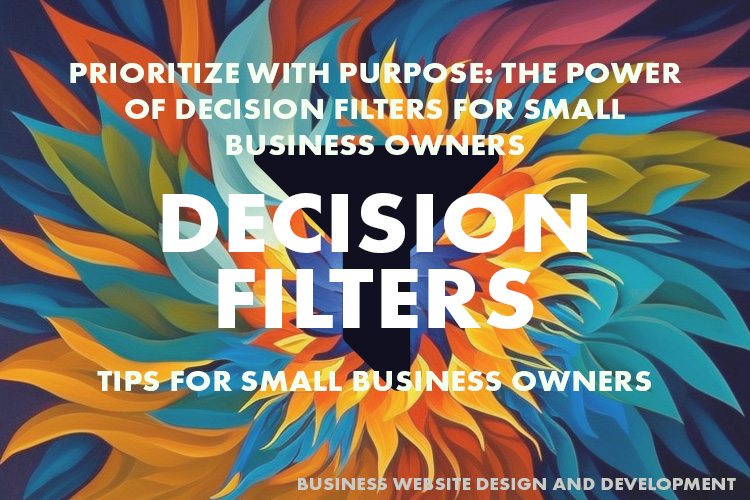Decision Filters
As a small business owner, it’s easy to get swept up in the day-to-day demands of running a company. Sometimes, you may lose sight of your personal and professional priorities, leading to decisions that aren’t in line with your goals or values. However, by setting decision filters, you can make it easier to stay focused on what matters most. Decision filters are a set of criteria that you establish to help guide your decision-making process. They remind you of your priorities and make it easier to say no to opportunities that don’t align with your goals. As you and your small business team are planning your year, consider setting decision filters around your priorities, such as spending time with family or pursuing certain business opportunities. By doing so, you can ensure that every decision you make is in line with your values and helps you achieve your desired outcomes.

Identifying Priorities
To establish effective decision filters, you need to first identify your personal and professional priorities. This will enable you to make decisions that align with your values and help you achieve your goals. Here are some key steps to help you identify your priorities:
A. Personal Priorities
Think about what matters most to you outside of work. This could include spending time with family and friends, pursuing hobbies, or volunteering. Ask yourself questions such as:
- What brings me the most joy and fulfillment in life?
- What are my personal values and beliefs?
- What activities do I enjoy most outside of work?
By answering these questions, you can start to identify your personal priorities and develop decision filters that support them.
B. Professional Priorities
Consider your goals and objectives for your small business. This could include things like increasing revenue, expanding your customer base, or developing new products. Ask yourself questions such as:
- What are my business goals for the year?
- What are the most important tasks and responsibilities for my business?
- What areas of my business require the most attention and resources?
By answering these questions, you can identify your professional priorities and develop decision filters that support your business objectives.
C. Aligning Priorities with Business Goals
It’s essential to align your personal and professional priorities with your small business goals. This will enable you to make decisions that support both your personal and professional success. Take some time to consider how your personal and professional priorities align with your business goals. Ask yourself questions such as:
- How can I incorporate my personal priorities into my business decisions?
- How can I leverage my professional priorities to achieve my personal goals?
- What opportunities exist to align my personal and professional priorities with my business goals?
By answering these questions, you can start to develop decision filters that align with both your personal and professional priorities and support your small business objectives.
Creating Decision Filters
Once you have identified your personal and professional priorities and aligned them with your business goals, you can start to create decision filters. Decision filters are a set of criteria that you use to guide your decision-making process. Here are some key steps to help you create effective decision filters:
A. Defining Decision Filters
To create effective decision filters, you need to define the criteria that you will use to evaluate opportunities and make decisions. Ask yourself questions such as:
- What are the most important factors to consider when making a decision?
- What values and priorities do I want to uphold in my decision-making process?
- What are the potential risks and benefits of each opportunity?
By answering these questions, you can start to define your decision filters and establish a set of criteria to guide your decision-making process.
B. Establishing Criteria for Decision Filters
To make your decision filters effective, you need to establish clear criteria for each filter. For example, if one of your decision filters is to prioritize family time, you might establish criteria such as:
- The opportunity must not require more than 40 hours of work per week.
- The opportunity must not require travel more than once a month.
- The opportunity must not interfere with scheduled family events or activities.
By establishing clear criteria for each decision filter, you can make it easier to evaluate opportunities and make decisions that align with your priorities.
C. Examples of Decision Filters for Small Business Owners
Here are some examples of decision filters that small business owners might use:
- Family Time: Will this opportunity require more time away from my family than I am comfortable with?
- Financial Impact: Will this opportunity have a positive financial impact on my business?
- Alignment with Mission: Does this opportunity align with my company’s mission and values?
- Work-Life Balance: Will this opportunity allow me to maintain a healthy work-life balance?
- Growth Potential: Does this opportunity have the potential to help my business grow and develop?
By using decision filters such as these, you can evaluate opportunities and make decisions that support your personal and professional priorities.
Implementing Decision Filters
Creating decision filters is an important step, but it’s equally important to implement them effectively. Here are some key steps to help you implement decision filters:
A. Incorporating Decision Filters into Decision-Making Processes
To make your decision filters effective, you need to incorporate them into your decision-making processes. This means using your decision filters to evaluate opportunities and make decisions that align with your priorities. Consider incorporating decision filters into your planning and review processes. For example, before committing to a new project or opportunity, evaluate it against your decision filters to ensure that it aligns with your priorities.
B. Communicating Decision Filters to Stakeholders
It’s important to communicate your decision filters to stakeholders, including employees, partners, and customers. By doing so, you can ensure that everyone is aware of your priorities and decision-making processes. This can help build trust and confidence in your business. Consider including your decision filters in your company mission statement or employee handbook, and communicate them regularly in team meetings and company updates.
C. Adjusting Decision Filters as Priorities or Circumstances Change
As your priorities or circumstances change, it may be necessary to adjust your decision filters. For example, if you experience a significant life event such as the birth of a child, you may need to adjust your family time decision filter to accommodate your new responsibilities. It’s important to regularly review your decision filters and make adjustments as needed to ensure that they continue to align with your priorities.
By incorporating decision filters into your decision-making processes, communicating them to stakeholders, and adjusting them as needed, you can make more intentional decisions that align with your personal and professional priorities.
Benefits of Decision Filters
Implementing decision filters can have significant benefits for small business owners. Here are some of the key benefits:
A. Improved Decision-Making
Decision filters provide a clear framework for evaluating opportunities and making decisions. By using decision filters to guide your decision-making process, you can make more informed and intentional decisions that align with your priorities. This can lead to better outcomes and more effective use of your time and resources.
B. Enhanced Productivity
By using decision filters to evaluate opportunities, you can focus on those that align with your priorities and avoid distractions and time-wasting activities. This can lead to increased productivity and better use of your time and resources.
C. Reduced Stress and Overwhelm
Small business owners often face a range of competing demands and priorities. By using decision filters, you can prioritize what’s most important and say no to opportunities that don’t align with your priorities. This can help reduce stress and overwhelm and lead to a better work-life balance.
D. Alignment with Personal and Professional
Goals Implementing decision filters can help small business owners ensure that their decisions align with their personal and professional goals. By prioritizing what’s most important to you and your business, you can make decisions that support your long-term goals and vision.
Overall, implementing decision filters can help small business owners make more intentional decisions, increase productivity, reduce stress and overwhelm, and align with their personal and professional goals.

- Saboteur vs. Sage
- Cost vs. Worth
- Contentment
- Minor vs. Major
How to make great decisions
Making decisions can be a challenging task, especially when faced with multiple options and conflicting priorities. However, indecision can often lead to missed opportunities and setbacks. It’s important to have a clear and effective decision-making process.
Here are four decision filters that you can use to make great decisions:
- Saboteur vs. Sage: The first decision filter involves evaluating whether your decision is being influenced by your inner critic or your inner wisdom. Your saboteur is the voice of self-doubt and fear that can hold you back from making decisions that align with your values and goals. Your sage, on the other hand, is the voice of intuition and insight that can guide you toward decisions that are in your best interest.
- Cost vs. Worth: The second decision filter involves evaluating the cost versus the worth of a decision. This means considering not only the financial cost, but also the time, energy, and opportunity cost associated with a decision. By weighing the cost against the potential value or benefit, you can make more informed and strategic decisions.
- Contentment: The third decision filter involves considering whether a decision aligns with your values and brings you contentment. It’s important to evaluate whether a decision is in line with your personal and professional goals, as well as your core values and beliefs. Making decisions that align with your values and bring you contentment can lead to greater satisfaction and fulfillment in life.
- Minor vs. Major: The fourth decision filter involves evaluating the significance of a decision. Is it a minor decision that won’t have a significant impact on your life or business, or is it a major decision that could have far-reaching consequences? By considering the importance of a decision, you can prioritize your time and energy accordingly.
By using these decision filters, you can evaluate opportunities and make decisions that align with your priorities and goals. Making great decisions can lead to greater success and fulfillment in both your personal and professional life.
Conclusion
As a small business owner, it’s easy to get pulled in many directions and lose sight of your priorities. However, by creating and using decision filters, you can prioritize what’s most important and make more intentional decisions that align with your personal and professional goals.
In this post, we’ve explored the importance of identifying priorities, creating decision filters, and implementing them effectively. By doing so, you can reap the many benefits of decision filters, including improved decision-making, enhanced productivity, reduced stress and overwhelm, and alignment with your personal and professional goals.
We encourage you to take the time to identify your personal and professional priorities and create decision filters that align with them. Incorporate decision filters into your daily operations, and communicate them to your stakeholders. Regularly review and adjust your decision filters as needed to ensure they continue to align with your priorities.
Incorporating decision filters into your decision-making process can help you make more informed and intentional decisions, increase productivity, reduce stress and overwhelm, and ultimately achieve your long-term goals. So take the first step and start creating your decision filters today.


